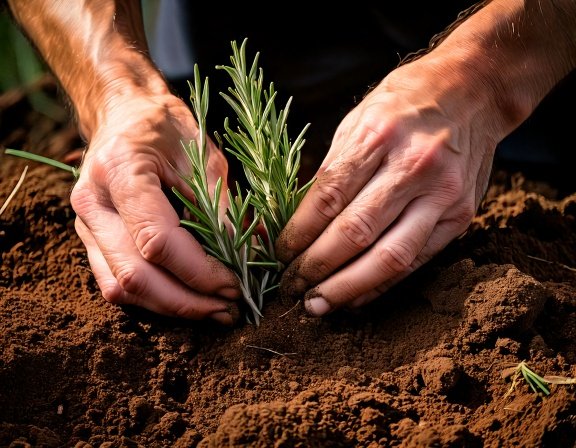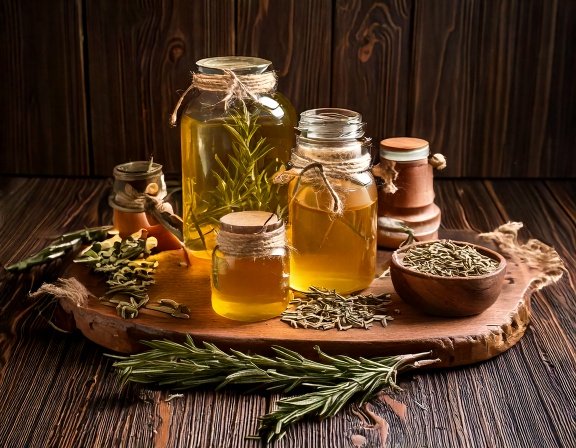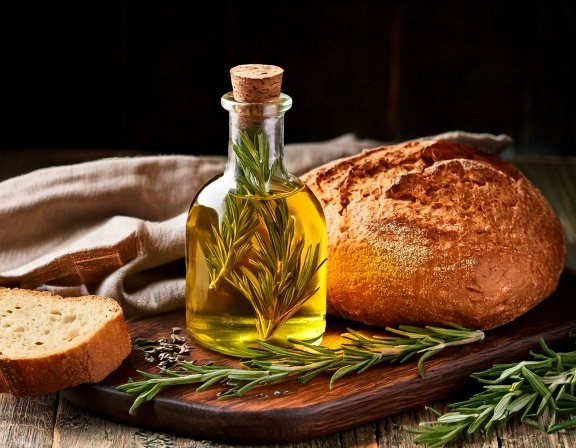Rosemary: Garden Tips for a Potent Culinary and Wellness Herb

Freebie: Vitamin C & Skin Glow Mini-Guide
Rosemary: Fragrance, Folklore & Function
Fun Fact: Ancient Greeks believed rosemary strengthened memory—students wore rosemary garlands during exams to improve recall!


Successfully Growing Rosemary at Home
Growing rosemary at home is both rewarding and practical—it’s a hardy, aromatic evergreen that adds beauty, fragrance, and endless use in the kitchen and home apothecary. Known for its resilience and longevity, rosemary can flourish for years when given the right care. Whether you’re planting it in a sunny garden bed or a container by the window, this Mediterranean herb rewards consistency and sunlight with lush, fragrant growth all year round.
Plant Type:
Rosemary is an evergreen perennial shrub that retains its needle-like leaves through all seasons. Its woody stems and aromatic foliage make it a long-lasting addition to herb gardens, borders, or pots, and a valuable companion plant for natural pest control.
Hardiness Zones:
Ideal for USDA Zones 7–11, rosemary thrives in warm, dry climates. In cooler regions, it can easily be grown in pots and brought indoors during winter. Container-grown rosemary adapts well to indoor environments if provided with bright light and good airflow.
Sunlight:
This sun-loving herb requires at least 6–8 hours of direct sunlight daily. Outdoors, plant it in a bright, open area free from shade. Indoors, place it on a sunny windowsill (preferably south-facing) or under a grow light to prevent legginess and keep its oils rich and aromatic.
Soil Requirements:
Rosemary prefers well-draining, sandy or rocky soil that mimics its native Mediterranean habitat. Slightly alkaline to neutral soil (pH 6.5–7.5) promotes optimal nutrient uptake and flavor intensity. Poor drainage is rosemary’s biggest enemy—always ensure roots stay aerated and dry between waterings. A blend of cactus mix and compost makes an ideal potting base for container-grown plants.
Watering:
Water rosemary deeply but infrequently. Allow the top inch of soil to dry before watering again. Overwatering leads to root rot, so it’s better to err on the dry side. During cooler months, reduce watering frequency even further as growth slows down.
Propagation:
The easiest and most reliable way to grow rosemary is from cuttings or nursery plants. Take 4–6 inch stem cuttings from healthy, non-woody branches, strip the lower leaves, and place them in water or a sandy soil mix until roots develop (usually 2–3 weeks). Once rooted, transplant to individual pots or your garden bed. While rosemary can be grown from seed, germination is slow and unpredictable, making cuttings a faster and more dependable choice.
Feeding & Maintenance:
Rosemary isn’t a heavy feeder. Use compost or a diluted organic fertilizer once or twice per season to encourage steady growth. Regular pruning after flowering keeps the plant bushy and prevents it from becoming woody. Removing spent blooms also encourages more fragrant leaf production.
Container Growing Tips:
For potted rosemary, use a deep container (at least 12 inches) with ample drainage holes. Terracotta pots are ideal as they wick away excess moisture. Refresh the top layer of soil every spring, and rotate the pot occasionally to ensure even light exposure.
Quick Tip: The more you harvest and lightly prune rosemary, the fuller and more fragrant it becomes. With abundant sun, dry roots, and regular trimming, you’ll have a thriving plant that provides fresh leaves for cooking, tea, and home remedies year-round.
Java Brain: Quercetin, Ginkgo & Nature’s Nootropics
- Includes natural neuro‑supportive botanicals like quercetin & Ginkgo biloba
- Zero synthetic stimulants—just plant-based mental support
- Designed to synergize with your day, not take it over
SKIN GLOW BLUEPRINT (PDF)
Discover plant-based skin routines and a carrier oil matrix for a radiant, nourished complexion—inside and out.
Download Free GuideGardener’s Tip
Get the Rosemary Grower’s Starter Kit—includes pruning shears, organic plant food, and labeled pots. Make growing and harvesting rosemary easy!
Explore Amazon for Gardening Kit
Rosemary Plant Care
Rosemary (Rosmarinus officinalis) is a low-maintenance, sun-loving herb that thrives when given the right balance of warmth, airflow, and well-drained soil. Native to the Mediterranean coast, it prefers conditions that mimic its natural habitat—bright light, dry roots, and gentle pruning to stay lush and aromatic. With the proper care, a single rosemary plant can live and flourish for years, offering fragrant leaves for cooking, teas, and natural remedies all year long.
1. Sunlight:
Rosemary loves full sun—aim for at least 6–8 hours of direct sunlight daily. Outdoors, plant it in the brightest spot available. Indoors, place rosemary near a south-facing window or supplement with grow lights during shorter winter days to keep foliage vibrant and healthy.
2. Soil:
Use well-draining, sandy or loamy soil to prevent root rot. A mixture of potting soil, coarse sand, and perlite mimics its native coastal terrain. Avoid heavy, compacted, or constantly moist soils—rosemary’s roots prefer breathing room and dryness between waterings.
3. Watering:
Rosemary is drought-tolerant once established. Water deeply but infrequently—only when the top inch of soil feels dry. Overwatering is the most common cause of decline. In humid regions or container gardens, ensure pots have excellent drainage and never leave standing water in saucers.
4. Temperature & Humidity:
Rosemary thrives in mild, warm climates (60–80°F / 15–27°C). Protect from frost by bringing potted plants indoors during winter or covering outdoor shrubs with breathable fabric. It prefers dry air and moderate humidity; good airflow prevents mildew or fungal growth on the leaves.
5. Feeding:
Feed rosemary lightly once or twice during the growing season with organic compost tea or diluted seaweed fertilizer. Too much fertilizer can dull its flavor and scent, so err on the side of restraint. Nutrient-rich soil is usually enough to sustain it year-round.
6. Pruning:
Regular trimming keeps rosemary full and bushy. After flowering or at the start of spring, prune back up to one-third of the plant to encourage new shoots. Remove any woody or leggy stems to maintain shape and promote healthy growth. Frequent harvesting also acts as natural pruning.
7. Pests & Problems:
Rosemary is naturally pest-resistant, but watch for aphids, spider mites, or powdery mildew in humid environments. Improve airflow, avoid overwatering, and use a light neem oil spray if needed—rosemary and neem make excellent natural companions for organic pest control.
8. Container Growing Tips:
If growing in pots, choose containers at least 12 inches deep with drainage holes. Terracotta pots are ideal—they allow soil to dry between waterings. Rotate the plant occasionally to ensure even light exposure, and refresh the topsoil each spring to keep nutrients balanced.
Quick Tip: Rosemary thrives on a “less is more” approach—lots of sun, light watering, and occasional pruning. Mimic its native coastal roots, and your plant will reward you with abundant, aromatic growth and year-round beauty.
NeuroPrime: Alpha GPC, L-Tyrosine & Botanical Power
- Includes key nootropic ingredients like Alpha GPC, L-Tyrosine, N-Acetyl-L-Cysteine
- Also marketed with antioxidant support from Moringa
- Non-stimulant formula aimed at supporting focus, mood, and cognition safely
SKIN GLOW BLUEPRINT (PDF)
Discover plant-based skin routines and a carrier oil matrix for a radiant, nourished complexion—inside and out.
Download Free GuideGardener’s Tip
Active Ingredient: Rosmarinic Acid—a potent antioxidant and anti-inflammatory compound supporting cognitive function and reducing stress.
Harvesting and Storing Rosemary
One of the joys of growing rosemary is how easy it is to harvest and preserve. This hardy evergreen keeps its fragrance and flavor for months when handled properly, making it an ideal year-round herb for cooking, teas, and home remedies. The key to preserving its vibrant essential oils is harvesting at the right time and drying it gently to lock in aroma and potency.
When to Harvest:
The best time to harvest rosemary is in the late morning after the dew has evaporated but before the sun becomes too strong. At this point, the natural oils that give rosemary its signature scent and healing properties are at their highest concentration. You can begin light harvesting once the plant is well established (about 8–10 inches tall), but the most flavorful sprigs come just before or during flowering, when tiny blue or purple blossoms start to appear.
How to Harvest:
Use sharp scissors or pruning shears to snip 4–6 inch sprigs from the tips of healthy branches. Cut just above a leaf node or branching point—this encourages new growth and keeps the plant full and bushy. Never remove more than one-third of the plant at a time, as rosemary thrives with steady but moderate pruning. Frequent harvesting actually stimulates fresh growth and increases oil production in new leaves.
Drying Rosemary:
Drying rosemary concentrates its oils and flavor while extending its shelf life. Gather small bundles of sprigs and hang them upside down in a dry, shaded, and well-ventilated space for 1–2 weeks. Alternatively, spread them on a mesh rack or tray away from direct sunlight. If using a dehydrator, set it to 95–105°F (35–40°C) to preserve the volatile oils. You’ll know the rosemary is ready when the needles feel crisp and easily crumble between your fingers.
Storing Dried Rosemary:
Once completely dry, strip the needles from the stems and store them in airtight glass jars or tin containers away from heat, light, and moisture. Properly dried rosemary retains its full flavor and aroma for up to a year. For maximum freshness, crush or grind the leaves only right before use. If stored near strong spices, keep it sealed to prevent scent absorption.
Storing Fresh Rosemary:
To keep rosemary fresh, wrap a few sprigs in a slightly damp paper towel and place them inside a reusable bag or container in the refrigerator—they’ll last about two weeks. For long-term preservation, freeze rosemary leaves or sprigs in olive oil using an ice cube tray. Once frozen, pop the cubes into a storage container for ready-to-use flavor boosts in cooking or herbal tonics.
Bonus Tip:
Rosemary harvested before bloom tends to be more pungent and resinous, perfect for culinary use, while post-bloom harvests are gentler—ideal for infusions, bath soaks, and skincare blends. Adjust your harvest timing depending on whether your goal is flavor or fragrance.
Quick Tip: Regular trimming keeps your rosemary plant healthy and productive. Snip generously, dry slowly, and store carefully—you’ll have a year-round supply of this aromatic, healing herb at your fingertips.
Harvesting & Drying Rosemary
- Best Harvest Time: Collect rosemary in the late morning after dew has fully evaporated. This is when volatile oils reach peak aromatic potency, ensuring superior flavor and fragrance.
- How to Harvest: Use clean shears to snip tender, green tips regularly. Avoid cutting into woody stems to maintain vigorous regrowth.
- Drying: Gather small bundles of sprigs and hang them upside down in a shaded, well-ventilated area. This slow-drying process preserves essential oil integrity.
- Storage: Once fully dried and brittle to the touch, store rosemary in airtight containers, away from direct heat and light, to retain potency for up to a year.
Gardener’s Tip
Fun Fact: Rosemary symbolizes remembrance—in ancient times, it was commonly included in bouquets and ceremonies to honor ancestors and loved ones.
Shop premium Organic Rosemary Dried & Oil for teas, oils, and culinary infusions—sustainably grown, non-GMO, always potent.
Organic Rosemary at Amazon
Rosemary in the Kitchen & Home Remedies
Rosemary (Rosmarinus officinalis) is far more than a fragrant kitchen herb—it’s a time-honored botanical used for both flavor and healing. With its invigorating pine-like aroma and rich antioxidant profile, rosemary enhances digestion, memory, and circulation while adding warmth and depth to countless dishes. In natural medicine, it’s celebrated for stimulating the scalp, soothing sore muscles, and refreshing the mind. Whether used in cooking or homemade remedies, rosemary brings vitality to both body and home.
In the Kitchen:
Fresh or dried rosemary pairs beautifully with roasted vegetables, potatoes, chicken, and bread. Its essential oils not only deepen flavor but also aid in digestive support and gut health. Infuse olive oil or honey with rosemary sprigs for a fragrant kitchen staple that doubles as a wellness boost.
At Home:
Use rosemary for simple, natural remedies that cleanse and invigorate:
- Rosemary Hair Rinse: Steep a handful of rosemary sprigs in hot water, cool, and pour over hair after shampooing to stimulate growth and add shine.
- Steam Inhalation: Add rosemary leaves to a bowl of hot water, cover your head with a towel, and inhale to clear congestion and refresh the mind.
- Herbal Bath Soak: Combine rosemary with lavender and Epsom salt for a relaxing, muscle-soothing soak that energizes the senses.
- Rosemary Cleaning Vinegar: Infuse white vinegar with rosemary sprigs and lemon peel for a natural, aromatic surface cleaner that purifies your home.
Quick Tip: Keep a small rosemary plant by your kitchen window—it purifies the air, inspires cooking creativity, and provides a ready supply for teas, tonics, and healing recipes year-round.
Ways to Use Rosemary
- Culinary Use: Adds aroma and flavor to roasted vegetables, meats, breads, and soups—a Mediterranean kitchen essential.
- Rosemary Tea: Brew for mental clarity, stress relief, and gentle digestive support.
- Rosemary Hair Rinse: Improves scalp circulation and encourages thicker, healthier hair growth.
- Infused Oil: Perfect for cooking, topical massage blends, or as a natural skin soother.
- Active Ingredient Highlight: Rosemary essential oil contains 1,8-Cineole, a compound known to enhance memory, focus, and overall cognitive performance.

Grow Your Own Rosemary for Wellness & Flavor
Cultivating rosemary at home brings culinary delight and wellness benefits directly into your kitchen and medicine cabinet. Begin your herbal gardening journey with this versatile, aromatic herb today.
Explore more: Grow Your Own Remedies Series
- WebMD – Rosemary Benefits
- American Botanical Council – Rosemary Monograph
- Modern Herbal – A Modern Herbal: Rosemary